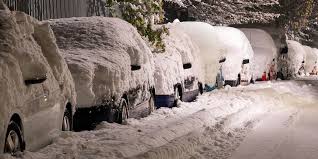
- Details
- By FEMA
Winter officially begins this Saturday, Dec. 21, bringing freezing rain, snow and plummeting temperatures. Families can prepare now to stay safe, warm and protect their homes with guidance from FEMA’s #WinterReady campaign.
“It’s never too early to think about what you would do if stranded on the side of the road or stuck at home without power during a snowstorm,” said FEMA Region 5 Regional Administrator Tom Sivak. “Taking steps today—like making a plan and assembling emergency kits with essential items like food, water, medications and pet supplies—can make all the difference when winter weather strikes.”
Here are a few things to keep in mind as winter rolls in:
- Wear a coat and dress in layers if you work outside or participate in outdoor activities. This will help regulate your body heat and keep you warm. Be sure to keep your skin covered by wearing a hat, scarf and mittens. Hats help keep the body warmer and mittens are more effective than gloves.
- Know what to do if you experience frostbite or hypothermia. If the cold causes pain in your body, numb or tingly skin, slurred speech, or shivering, go indoors immediately. Remove wet clothing, wrap up in a warm blanket and if you can, sip on warm fluids to stabilize your body temperature.
- Gather supplies for your emergency kits. It’s important to keep an emergency kit in your home. This kit should include nonperishable food, a can opener, water, blankets, prescription medications, a weather radio, a flashlight with extra batteries, a portable cell phone charger, kid-friendly activities, and pet food. It’s also a good idea to make sure everyone in the family has the phone numbers for emergency contacts. It’s also important to keep an emergency kit in your vehicle in case you are stranded in the cold. This kit should include an ice scraper, jumper cables, a small shovel, blankets, nonperishable food, water and a portable cell phone charger.
- Heat your home safely. If you use a space heater, remember to keep it at least three feet away from items like curtains, rugs, furniture, bedding and other items that can burn. The heaters should be plugged directly into the wall and the cords should not be frayed or damaged. Never use a gas stovetop or oven to heat your home. This can release carbon monoxide into the air and cause serious health risks, even death.
- Check on elderly friends and neighbors. Older adults often have a harder time regulating body temperature, so they are at a higher risk of experiencing cold-weather related injuries. Be sure to check in on them to see if their heat is working properly and they have what they need to make it through the cold.
To learn more about how to prepare for extreme cold and severe winter weather, visit #WinterReady | Ready.gov. The #WInterReady campaign also offers messaging, graphics and resources to help educate the public on the risks of winter weather, promote fire safety and urge caution when travelling in winter weather. Access these tools by visiting #WinterReady Partners Toolkit.
Help us tell the stories that could save Native languages and food traditions
At a critical moment for Indian Country, Native News Online is embarking on our most ambitious reporting project yet: "Cultivating Culture," a three-year investigation into two forces shaping Native community survival—food sovereignty and language revitalization.
The devastating impact of COVID-19 accelerated the loss of Native elders and with them, irreplaceable cultural knowledge. Yet across tribal communities, innovative leaders are fighting back, reclaiming traditional food systems and breathing new life into Native languages. These aren't just cultural preservation efforts—they're powerful pathways to community health, healing, and resilience.
Our dedicated reporting team will spend three years documenting these stories through on-the-ground reporting in 18 tribal communities, producing over 200 in-depth stories, 18 podcast episodes, and multimedia content that amplifies Indigenous voices. We'll show policymakers, funders, and allies how cultural restoration directly impacts physical and mental wellness while celebrating successful models of sovereignty and self-determination.
This isn't corporate media parachuting into Indian Country for a quick story. This is sustained, relationship-based journalism by Native reporters who understand these communities. It's "Warrior Journalism"—fearless reporting that serves the 5.5 million readers who depend on us for news that mainstream media often ignores.
We need your help right now. While we've secured partial funding, we're still $450,000 short of our three-year budget. Our immediate goal is $25,000 this month to keep this critical work moving forward—funding reporter salaries, travel to remote communities, photography, and the deep reporting these stories deserve.
Every dollar directly supports Indigenous journalists telling Indigenous stories. Whether it's $5 or $50, your contribution ensures these vital narratives of resilience, innovation, and hope don't disappear into silence.
 The stakes couldn't be higher. Native languages are being lost at an alarming rate. Food insecurity plagues many tribal communities. But solutions are emerging, and these stories need to be told.
The stakes couldn't be higher. Native languages are being lost at an alarming rate. Food insecurity plagues many tribal communities. But solutions are emerging, and these stories need to be told.
Support independent Native journalism. Fund the stories that matter.
Levi Rickert (Potawatomi), Editor & Publisher
